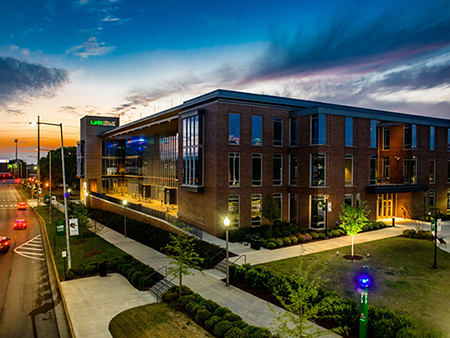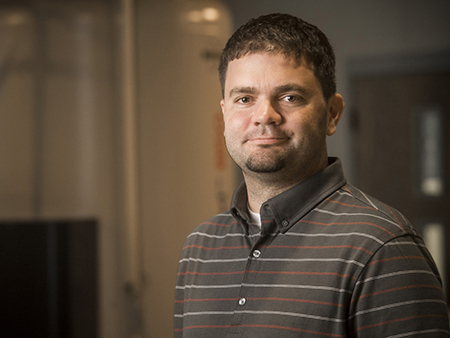 Everyone was fast this spring: the businesses that contributed to the fund, the scientists and physicians who crafted research proposals, and the senior School of Medicine researchers who chose which proposals got money.Chad Petit, Ph.D., spent the last five days of March working late into the night after his children, Amelia and Elijah, 12 and 9, had gone to sleep. Across metro Birmingham, 51 other University of Alabama at Birmingham researchers faced the same time crunch — create a COVID-19 research proposal in just five days, to compete for emergency COVID-19 funding raised through UAB and generous business donors in Birmingham and Montgomery.
Everyone was fast this spring: the businesses that contributed to the fund, the scientists and physicians who crafted research proposals, and the senior School of Medicine researchers who chose which proposals got money.Chad Petit, Ph.D., spent the last five days of March working late into the night after his children, Amelia and Elijah, 12 and 9, had gone to sleep. Across metro Birmingham, 51 other University of Alabama at Birmingham researchers faced the same time crunch — create a COVID-19 research proposal in just five days, to compete for emergency COVID-19 funding raised through UAB and generous business donors in Birmingham and Montgomery.
The RFA, or request for applications, had gone out from the UAB School of Medicine and the Hugh Kaul Precision Medicine Institute at 1:28 p.m., Wednesday, March 25. Research proposals — limited to two pages of 12-point font — were due Monday, March 30, by 5 p.m. The grant application process, usually a journey of months, was compressed into a long weekend.
But by the deadline, 52 applications had rolled in, a sign of the nimbleness, quality and breadth of UAB research in the time of COVID. Here is how one researcher came up with his ideas, how the merits of all 52 applications were judged and how the business community raised $1.1 million in just 20 days.
A UAB virus researcher
Petit, an assistant professor in the UAB Department of Biochemistry and Molecular Genetics, studies the influenza virus, including the infamous strain from the 1918-19 flu pandemic that killed 40 million-50 million people worldwide.
Serendipitously, Petit had done his Ph.D. work on the SARS coronavirus that first infected people in China in 2002, causing the severe acute respiratory syndrome. As a result, he had begun to think about the novel coronavirus of 2019 as the deadly COVID-19 pandemic began.
“There were a few things that went through my mind,” Petit said. “Although this is a brand-new virus, I could use previous research done on closely related coronaviruses — known as CoVs — to form ideas about how to investigate the emerging virus. The first step for me was to determine how similar this new coronavirus was to other coronaviruses — particularly the SARS-CoV.”
|
For more information on the urgent COVID-19 research fund, see: |
Petit looked up the RNA sequence of the novel COVID-19 virus, available at the National Center for Biotechnology Information, at the National Institutes of Health. From the RNA sequence, Petit could identify the amino acid sequence of proteins encoded by the virus.
“The goal was to identify proteins in SARS-CoV-2, the virus that causes COVID-19, that were similar to proteins in other coronaviruses and then look to see what research had been done on those viruses,” Petit said. “The thought was that we can formulate ideas about how to combat SARS-CoV-2 by looking into previous research for similar viruses.”
Petit found a protein — the non-structural protein 1, or nsp1 — that was very similar in both SARS-CoV from 2002 and the new SARS-CoV-2. “The next step,” Petit said, “was to look up previous research that was performed on the SARS-CoV version of this protein and determine if this was a target that could be exploited for antiviral development to treat COVID-19.”
To establish the baseline knowledge needed for a robust outline of what needed to be done, Petit read the findings of around 60 papers — some more thoroughly than others. “It turned out that not only was nsp1 a protein that could be exploited for the development or repurposing of already available drugs,” Petit said, “it could also be utilized in the rational design of a future vaccine.”
 Etty “Tika” Benveniste, Ph.D.Critical feedback — an important step
Etty “Tika” Benveniste, Ph.D.Critical feedback — an important step
Petit did not think alone; he bounced his ideas off other UAB scientists. He made a last-minute request to present his ideas to a scheduled meeting of his department’s grant club, where scientists present their ideas to other faculty to get critical feedback. Narendra Wajapeyee, Ph.D., professor and vice chair for Research in the Department of Biochemistry and Molecular Genetics, gave Petit 20 minutes the next day to present his ideas to the rest of the faculty, including department Chair David Bedwell, Ph.D.
“Everyone gave excellent feedback and opinions on how to improve the proposal,” said Petit, who also got critiques from researchers in other UAB departments. “I then had to put pen to paper and provide the rationale why this was a good target for funding. One of the major criteria in the RFA for COVID-19 research funding emphasized completing the projects quickly, given the dire threat posed by the pandemic. “I wrote my proposal where we could quickly learn whether my idea was correct,” Petit said, “and I planned a set of experiments with the idea of getting the most bang for the buck.”
Choosing the best among 52 proposals
A normal review process for grant applications takes months, though the shorter pilot projects can be somewhat quicker.
With 52 proposals jamming their mailbox on March 30, Etty “Tika” Benveniste, Ph.D., senior vice dean for Basic Sciences, UAB School of Medicine, and Matt Might, Ph.D., director of the Hugh Kaul Precision Medicine Institute at UAB, had to figure out which ones merited support from the Urgent COVID-19 Clinical Research and Laboratory Research Fund at UAB Medicine — money being raised in a month from generous Alabama businesses.
The research had to be urgent. “Given the rapidly escalating nature of the crisis, proposals that had time-to-impact in weeks or months would be prioritized,” Benveniste said. “We needed to have results within a short time frame of three to six months.”
To speed the review process, five senior research leaders from the UAB School of Medicine went through all 52 applications, looking for both good science and a fast time frame. “We ended up with 20 applications that we felt really had a lot of potential,” Benveniste said. “I want to emphasize that it was heart-rending going from 52 to 20. Many of the projects that were not funded were very strong scientifically, but had longer timelines toward results.”
Next, the five senior research leaders gave each of the remaining 20 proposals an individual review, scoring them in the typical NIH fashion of one to nine, where one is the strongest and nine the weakest. The five individual scores for each grant were averaged to rank the proposals.
They were done by mid-April.
“We were able to fund 14 of the 20 with the money we had,” Benveniste said. One was Petit’s nsp1 study. On Friday, May 1, each researcher got half of their funding, with the requirement of a progress report at three months, instead of the usual six months.
“Depending on that progress report, we will award the rest of the dollars,” Benveniste said. “We want to be sure these dollars are going to a really good use. If a project is not successful, that’s fine. That happens in science.”
 Chad Petit, Ph.D.The business community responds
Chad Petit, Ph.D.The business community responds
At the same time the RFA and reviews were taking place, the business community was springing into action to fund this urgent research. In just 20 days, the Birmingham business community and one donor from Montgomery raised $1.1 million for the urgent clinical and laboratory COVID-19 research at UAB. The strength and rapidity of this support are already at work in labs and clinics throughout UAB and UAB Hospital.
Here is how it happened.
Soon after a COVID-19 national emergency was declared in the United States, Jim Gorrie, CEO of Brasfield & Gorrie, asked UAB President Ray Watts, M.D., to talk to a group of CEOs about COVID-19 needs and opportunities.
Watts noted that humans have never experienced infection with the novel coronavirus that causes COVID-19, and that Alabama is particularly vulnerable to the ravages of this disease because Alabamians have high rates of conditions that increase death from the infection — diabetes, heart disease, obesity and cancer.
Watts shared three pages of urgent needs at UAB for clinical research and laboratory research meant to save lives, understand the disease and find treatments. He said UAB was seeking $1 million to support this COVID-19 research, which could start immediately and have results in a few months. He said any gifts would be leveraged further by pursuit of the $2 billion COVID-19 grant support being offered by the National Institutes of Health.
The next day, Gorrie sent out an email to the 21 business leaders who participated on the call. He said Brasfield & Gorrie would contribute to the UAB effort, “and I just wanted to encourage anyone else who can help to join in.”
“I know we all are dealing with issues and challenges across the board,” Gorrie said to fellow leaders. “No problem if you are not in a position to help at this time, and I will not be following up on this email. All gifts will be between you and UAB.” Gorrie gave UAB’s contact information and said, “Thanks for considering!”
The result? By April 14, Tom Brannan, vice president of Advancement, said UAB had received more than $1.1 million in gifts and commitments from 11 donors.
“I am not surprised by the response,” Gorrie said. “We have a strong business community that appreciates the work taking place at UAB.”
“We are very fortunate to have UAB in our community, and I cannot think of a more important institution for everyone in Birmingham to rally around during this strange time.”
| UAB is currently raising a second round of funds for competitive COVID-19 research proposals, due to the incredible response of worthy COVID proposals from UAB scientists and physicians. The goal is $500,000. To make a gift to this fund, contact Jessica Towns, jtowns7@uab.edu, executive director of Development in the UAB School of Medicine. |
Further payoffs down the road
The work-limited spring season at UAB saw a diverse team — business leaders and UAB Advancement, researchers and senior School of Medicine administrators — leap into action to counter COVID-19. This quick start will yield further payoffs down the road from the knowledge UAB researchers gain in the pilot studies, Benveniste says. “There will be many opportunities for new money,” she said. “The preliminary data generated by our pilots will form the basis for new grants and contracts.”
Petit — who uses structural techniques to understand how pathogens interact with the host — appreciates the speed of funding for his pilot research.
“I am thankful that the School of Medicine administration and the business community recognized the severity of this problem,” he said. “They reacted swiftly to mobilize the scientific community of UAB against COVID-19, and I am grateful to help contribute to the effort of getting COVID-19 under control.”